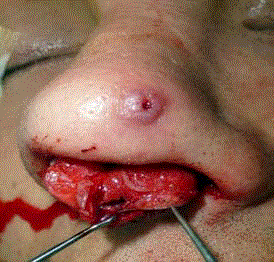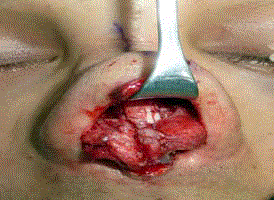Case Report
A Rare Complication after Rhinoplasty: Nasal Cutaneous Fistula
Ugur Horoz*
Department of Plastic Reconstructive and Aesthetic Surgery, Dr Ersin Arslan Training and Research Hospital,
Gaziantep, Turkey
*Corresponding author: Ugur Horoz, Department of Plastic Reconstructive and Aesthetic Surgery, Dr Ersin Arslan Training and Research Hospital, Gaziantep, Turkey
Published: 23 Aug, 2017
Cite this article as: Horoz U. A Rare Complication after
Rhinoplasty: Nasal Cutaneous Fistula.
Clin Surg. 2017; 2: 1599.
Abstract
Septorhinoplasty is one of the most challenging aesthetic and functional procedures for surgeons.
Nasal tip surgery (to refine the nasal tip) is a compulsory stage of rhinoplasty. Dome division is a
technique used for nasal tip surgery, especially for over projection and under projection of the nasal
tip. The technique has been modified since the idea was first introduced. Fistula complication after
rhinoplasty has rarely been reported. However, we had a 25-year-old male patient admitted to our
clinic with a lesion on his left nasal tip that had been there for six months. The physical examination
showed there was an erythematous, raised and non-healing lesion. When performing this patient’s
septorhinoplasty, we noticed nasal cutaneous fistula resulting from chronic nasal skin damage due
to a sharp, improperly cut and unfinished end of the lower lateral cartilage. Thus, for this case, we
are reporting nasal tip cutaneous fistula, a long-term complication of incorrectly performed dome
division surgery.
Keywords: Dome division; Fistula; Rhinoplasty
Introduction
Skin, fascia, muscle, bone, perichondrium, periosteum, nerves, vessels, fat and cartilage—the main supporting structure are the tissues involved in rhinoplasty. Complex problems with these tissues may lead to complications after the operation. Nasal tip projection is known as the most frequent single factor for postoperative deformity after rhinoplasty [1]. Nasal tip surgery is an important and challenging component of rhinoplasty cases. Various approaches have been reported for performing nasal tip surgery [1-3]. Dome division is one such procedure, used for nasal tip repositioning. Originally, the dome division technique was said to increase tip projection. However, this technique has also been used and modified for different types of cases [2,4,5]. Dome division divides the lower lateral cartilage into two parts: the medial and lateral segments. These segments are then advanced and sutured in either the anterior or posterior position to alter tip projection. Different complications after rhinoplasty have been reported before [1,3,6-10]. This case study describes an unusual complication of dome division surgery: nasal tip cutaneous fistula present four years after the rhinoplasty. To the best of our knowledge, this is the first reported case of cutaneous fistula complication after use of the dome division technique.
Case Presentation
A 25-year-old male patient underwent septorhinoplasty under general anesthesia at our clinic. During his initial examination, we noticed a small pustule on his left nasal tip. The patient had undergone open-approach aesthetic rhinoplasty five years before elsewhere. In this case report, we are reporting cutaneous skin fistula due to incorrectly performed dome division technique (Figure 1). The previous procedure was done without repairing or suturing the lateral or medial parts of the lower lateral cartilage, and the patient was improperly managed. The patient had limited information about the first operation. For the second operation, we performed open-approach septorhinoplasty. After the incisions, while dissecting the cartilage connection between the left lower lateral crura, we saw skin with vibrissae fusion. We noted the surgeon had probably cut the lateral crura for dome division, but either did not properly replace the two parts of cartilage into the new position, or used an early-absorbable suture. Regardless, the cut end of the cartilage may have led to damage of the nasal mucosal side, where the nasal hairs had turned inward into the lower lateral cartilage (Figure 2). The fistula formation and the hairs were removed. The lower lateral crura were repaired for aesthetic and functional nasal structure. Other procedures, such as osteotomies and grafts, were completed and the operation was finished. The cutaneous fistula formation was regressed within the one-month postoperative period. Neither complaints nor complications were reported during the follow-up period.
Figure 1
Figure 1
Intraoperative anterior view of the nasal cutaneous fistula, defect of
the lower lateral cartilage and vibrissa.
Figure 2
Discussion
Dome division is a method used to increase tip position without using columellar grafts. A modified version of the technique can change over projection, under projection, tip asymmetries and rotations [2,4]. Skin reaction, atrophy, fibrosis, numbness of the skin and soft tissues, blindness, fistula, mucous cysts, injuries of the orbital region, necrosis of eyelids due to infection and other rare complications have been reported [1-6]. These postoperative complications may be related to surgical techniques or may be unrelated to the surgery. Keles et al. [10] reported complications occurring after uneventful rhinoplasties as including herpes simplex virus infection, periorbital emphysema and second-degree burn on the nasal dorsum after primary septorhinoplasty cases. Giacomini and Ntomouchtsis reported nasal dorsum cysts and recurrent glabellar mucous cysts, respectively [6,7]. Alonso et al. [4] reported cutaneous fistula of the forehead as a long-term complication of rhinoplasty after migration of the porous polyethylene implant used for nasal dorsum augmentation. In this case, the fistula was related to chronic damage of the cut lower lateral crura approximately four years after the operation. Kuduban et al. [5] reported early skin reaction to the polydioxanone suture material, 24 days after the operation. Other reported complications occurring after rhinoplasty include necrosis of eyelids due to infection, rhinoliquorrhea, brain damage, fistulas between the cavernous sinus and carotid artery, aneurysms and thrombosis of the cavernous sinus, subcutaneous cysts and granulomas [1,4-9]. Dome division is a technique that can control the nasal tip position if performed correctly [2,4]. Gandomi et al. [5] reported that the most frequent complication of vertical dome division surgery is widening of the tip, given that the dome area is the narrowest part of the lower lateral cartilage and is removed during surgery. Chang et al. [4] reported the most common complication as bossae formation. Suture knots and visible cut cartilage ends were reported as the second most common complication of dome division [5]. Close follow up and communication with the patient is needed in order to resolve any early problems and to prevent predictable concerns. Nevertheless, as we know, there is no report of rhinoplasty complication in literature related to a wrongly performed dome division surgery after a rhinoplasty procedure.
Conclusion
In conclusion, nasal cutaneous fistula after rhinoplasty is a rare and unexpected complication. Rhinoplasty is an experience-based procedure with specific risks and complications. Awareness of all the risks involved, as well as what to do and what not to do will help with patient selection, the creation of a good preoperative plan, and good operative performance in order to yield acceptable results.
References
- Rettinger G. Risks and complications in rhinoplasty. GMS Curr Top Otorhinolaryngol Head Neck Surg. 2007;6:Doc08.
- Yu MS, Jang YJ. Modified vertical dome division technique for rhinoplasty in Asian patients. Laryngoscope. 2010;120(4):668-72.
- Alonso N, de Pochat VD, de Barros AR, Tavares LS. Long term complication after rhinoplasty using porous polyethylene implant: cutaneous fistula of the forehead. J Craniofac Surg. 2013;24(6):2176-8.
- Chang CW, Simons RL. Hockey-stick vertical dome division technique for over projected and broad nasal tips. Arch Facial Plast Surg. 2008;10(2):88-92.
- Gandomi B, Arzaghi MH, Rafatbakhsh M. The effectiveness of modified vertical dome division technique in reducing nasal tip projection in rhinoplasty. Iran J Med Sci. 2011;36(3):196-200.
- Kuduban O, Kuduban SD. Early skin reaction of polydioxanone suture material following septorhinoplasty. Am J Case Rep. 2015;16:276-8.
- Ntomouchtsis A, Kechagias N, Xirou P, Triaridis A, Xinou K, Vahtsevanos K. Recurrent glabellar mucous cyst: a rare post-rhinoplasty complication. Oral Maxillofac Surg. 2010;14(2):129-32.
- Giacomini PG, Topazio D, Di Mauro R. Unusual post-rhinoplasty complication: nasal dorsum cyst. Case Rep Otolaryngol. 2014;2014:617424.
- Lee KM, Han SC, Ho SY, Kim JT, Kim YH. Blindness resulting from orbital cellulitis following rhinoplasty. J Plast Reconstr Aesthet Surg. 2013;66(5):e129-32.
- Keles MK, Aksakal IA, Park TH, Yagmur Ç, Küçüker I. Unintentional Complications after Uneventful Rhinoplasty Operations: Case Reports and a Review of the Literature. Aesthetic Plast Surg. 2016;40(1):54-61.


